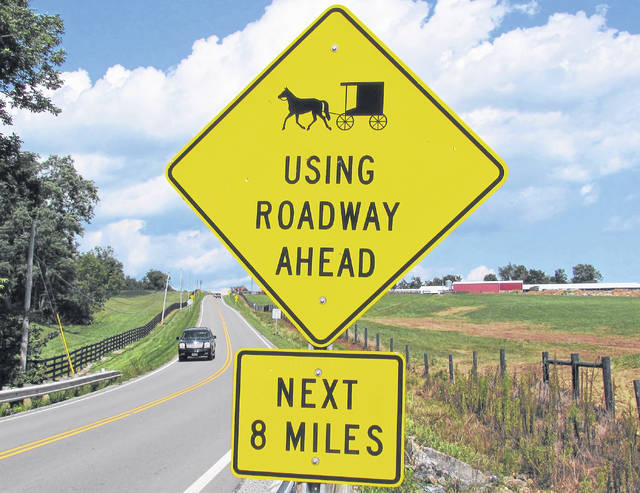
The last crash reported in The Times-Gazette involving a motor vehicle and an Amish buggy locally occurred in May on SR 138 just west of Duff Road between Hillsboro and Greenfield. Sunday night in northeastern Ohio, the state patrol reported a hit-and-run crash between an SUV and a buggy sent two Amish women to the hospital and an Amish boy was treated at the scene by paramedics.
Both crashes served to illustrate the need for caution on the part of both Amish and motor vehicle drivers, according to Lt. Stan Jordan, post commander of the Ohio State Highway Patrol in Wilmington.
“Above all, be cautious and stay back away from a buggy you meet on the road,” Jordan said. “When you get a good sight distance and come to a good place to pass, go ahead and ease your way around them.”
Data from the Ohio State Highway Patrol showed that there were more than 870 crashes involving a motor vehicle and an animal-drawn buggy or car, or an animal with a rider since 2014. On average, there are 120 crashes involving animal-drawn vehicles annually.
“A motorist should react just like it’s another car they’re coming up on,” Jordan said. “And when you go to pass them, make sure you stay clear of them because you don’t want to startle or frighten the horses.”
He said that many of the motor vehicle laws and rules of the road that apply to automobile drivers apply to Amish buggies as well.
“Obviously, there are some differences, but the main ones such as not going left of center and failure to yield the right of way are going to apply,” he said.
The Ohio Department of Transportation said that counties having significant Amish communities include Holmes, Wayne, Geauga, Ashland, Medina and Tuscarawas, although the Amish presence in recent years has migrated southward into Highland, Ross, Adams and Brown counties.
Legislation proposed by a pair of northern Ohio representatives would require horse-drawn buggies usually associated with the Amish to be equipped with a flashing light on the back.
House Bill 501, introduced by Republican state Reps. Scott Wiggam of Wooster and Darrell Kick of Loudonville on Feb. 11, would also require animal-drawn vehicles to use a newer, highly-reflective tape to insure greater visibility.
Both items are a part of a broader, revised road safety measure now before law makers in Columbus.
According to the Ohio Legislature website, the bill had its first reading before the Transportation and Public Safety Committee on May 19 and a second reading on June 20.
Under the new bill, animal-drawn vehicles would be required by law to employ the new reflective tape, as well as a flashing yellow light mounted on the highest rear part of the buggy, pony cart, or other type of vehicle.
In a recent highway safety study, ODOT and the state patrol identified three major causes of crashes between motor vehicles and horse-drawn buggies:
• Drivers underestimated how fast they were traveling compared with the buggy or pony cart they were approaching.
• Compromised visibility of the buggy due to their being covered in black vinyl, which made them nearly invisible at night except for the flashing red lights and reflective tape now required by law.
• Unexpected vehicle actions that were most often caused by the unpredictability of the animal pulling the buggy or cart.
“Treat them just like you would another vehicle on the road, but keep in mind, they’re a lot slower and those buggies are very fragile,” Jordan said.
According to the Young Center for Anabaptist and Pietist Studies, Ohio has the second-largest Amish population in the nation, now estimated at around 72,200.
Reach Tim Colliver at 937-402-2571.


